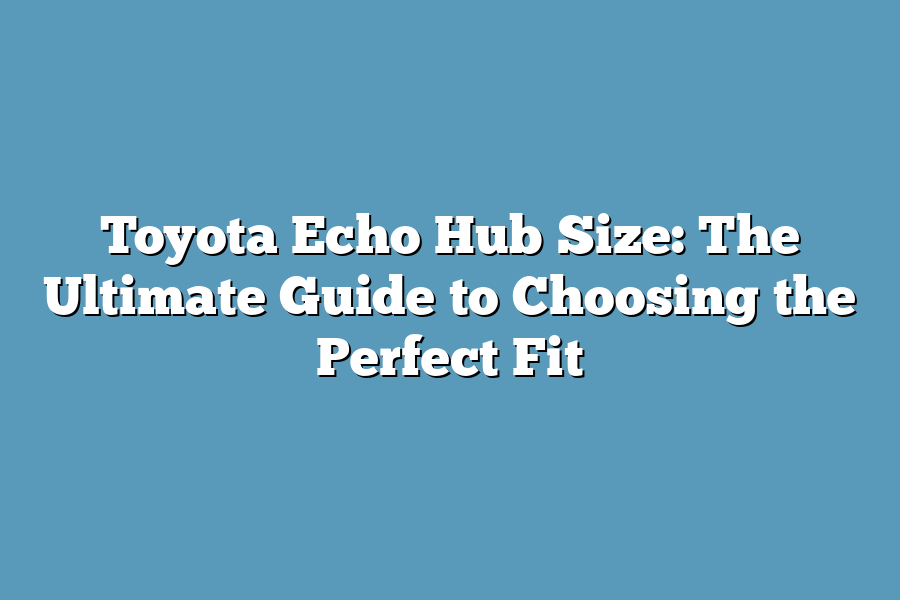The Toyota Echo has a compact car body style, which typically measures around 15-17 feet (4.5-5.2 meters) in length, and its wheelbase is around 101 inches (2.56 meters). The overall height of the vehicle usually ranges from 54-58 inches (1.37-1.47 meters), while its width can vary between 69-71 inches (1.75-1.8 meters).
I still remember the day I first learned about the importance of hub sizes when it comes to optimizing my Toyota Echo’s performance.
As a self-proclaimed car enthusiast and gearhead, I was determined to unlock the secrets behind achieving the perfect fit.
And boy, did I ever stumble upon some surprising revelations!
It all started with a simple question: what exactly is a hub size, and why does it matter so much?
In this ultimate guide, I’ll take you on a journey to demystify the world of hub sizes and show you how to choose the perfect fit for your Toyota Echo.
From understanding the basics of hub sizes to measuring yours like a pro, we’ll cover it all.
Whether you’re a daily driver looking for improved traction or an off-road enthusiast seeking more clearance, this guide will give you the tools you need to take your ride to the next level.
So, buckle up and get ready to dive into the fascinating world of hub sizes!
Table of Contents
Understanding Hub Sizes: The Key to Unlocking Your Vehicle’s Potential
As a car enthusiast, you know that getting the right fit for your Toyota Echo’s wheels is crucial for optimal performance.
But have you ever stopped to think about what makes a hub size perfect?
In this ultimate guide, we’ll dive into the world of hubs and explore how choosing the right size can make all the difference.
What’s a Hub, Anyway?
Before we dive into the nitty-gritty of hub sizes, let’s start with the basics.
A hub is the central part of your wheel assembly that attaches to your vehicle’s suspension system.
Its primary function is to support the weight of your vehicle and provide a stable platform for your tires.
Think of it like the foundation of a house – without a solid hub, your wheels are nothing more than fancy decorations.
Why Hub Size Matters
So, why is choosing the right hub size so important?
The answer lies in tire clearance and suspension geometry.
When you opt for a hub that’s too small or too large for your tires, it can lead to reduced clearance – a recipe for disaster when you’re cruising down the highway or tackling rough terrain.
On the other hand, if your hub is perfectly sized, it allows for optimal tire movement and reduces the risk of rubbing or vibrations.
Measuring Up: How Hub Sizes Are Calculated
Now that we’ve established why hub size matters, let’s talk about how they’re measured.
Typically, hub sizes are expressed in inches (e.g., 15×6) or centimeters (e.g., 39mm).
The first number refers to the diameter of the wheel opening, while the second number represents the width of the hub itself.
This combination determines the amount of tire clearance and suspension geometry available.
Real-World Examples: Off-Road, Street Racing, and Everything In-Between
So, how do different hub sizes impact your driving experience?
Let’s take a look at some real-world examples:
- Off-Road Enthusiasts: If you’re an off-road enthusiast, a larger hub size (e.g., 17×8) provides more clearance for bigger tires and increased suspension travel. This allows you to tackle rough terrain with confidence.
- Street Racers: For street racers, a smaller hub size (e.g., 15×5) can provide a lower center of gravity and improved handling around corners.
In this ultimate guide, we’ve covered the importance of understanding hub sizes and how they impact your Toyota Echo’s performance.
By choosing the right fit for your wheels, you’ll be able to tackle any terrain or driving style with confidence.
Remember – it’s all about finding that perfect balance between tire clearance and suspension geometry.
Stay tuned for our next installment as we dive into the world of wheel offsets!
Measuring Your Hub Size: Tips and Tricks
Hey there, Toyota Echo enthusiasts!
Are you tired of wondering if your current hub size is holding back your vehicle’s performance?
Well, wonder no more!
In this section, we’ll take a step-by-step approach to measuring your hub size like a pro.
And trust me, it’s easier than you think!
First things first, grab a tape measure or calipers and let’s get started.
Step-by-Step Measurement Guide
To measure your current hub size, follow these simple steps:
- Find the correct spot: Locate the hub assembly on your Toyota Echo. It’s usually centered in the wheel well, right behind the lug nuts.
- Get the measurements: Wrap a tape measure or calipers around the hub assembly, making sure to keep it straight and level. You want to capture the entire diameter of the hub.
- Take note: Record the measurement (in inches or millimeters) for future reference.
Avoid These Common Mistakes
Don’t let these common mistakes ruin your hub size measurement:
- Forget about lug nut thickness: Don’t forget to account for the thickness of your lug nuts when taking measurements! A single misplaced lug can throw off your entire measurement.
- Measure unevenly: Make sure you’re measuring consistently on both sides of the hub. Any discrepancies will give you an inaccurate reading.
Case Study: Measuring Up for Better Performance
Meet John, a Toyota Echo enthusiast who took his hub size measurement game to the next level.
He measured his current hubs and found that they were actually 1mm undersized!
With this new information, he was able to choose the perfect fit for his wheels, resulting in improved performance and a smoother ride.
Don’t let hub size uncertainty hold you back any longer!
Take control of your measurement game and unlock better performance for your Toyota Echo.
Stay tuned for our next section, where we’ll dive deeper into the world of hub sizes and what they mean for your vehicle’s performance.
Choosing the Right Hub Size for Your Toyota Echo
As a Toyota Echo owner, you’re probably wondering how to choose the perfect hub size for your ride.
With so many options out there (12×1, 15×8, 17×9, and more!), it can be overwhelming.
But fear not, friend!
In this ultimate guide, we’ll break down the pros and cons of each popular hub size option and provide recommendations based on how you use your Toyota Echo.
The Most Popular Hub Sizes for Toyota Echo
Before we dive into the benefits and drawbacks of each hub size, let’s take a look at some of the most popular options out there:
- 12×1: A smaller hub size that provides increased clearance for those pesky speed bumps and potholes.
- 15×8: A moderate-sized hub that offers a balance between stability and clearance.
- 17×9: A larger hub size that’s perfect for off-road enthusiasts or those who like to push their Echo to the limit on track.
The Pros and Cons of Each Hub Size Option
Now that we’ve covered some of the most popular hub sizes, let’s weigh the pros and cons of each:
12×1: Increased Clearance Meets Reduced Stability
Pros:
- Tons of clearance for those pesky speed bumps and potholes
- Can be a great option for daily driving or commuting
Cons:
- May compromise stability at higher speeds
- Not ideal for off-road enthusiasts or track racers
15×8: The Goldilocks Hub Size?
Pros:
- Offers a balance between clearance and stability
- Suitable for most driving conditions, including daily commutes and casual cruising
Cons:
- May not provide enough clearance for extreme off-roading
- Not ideal for high-performance driving or track racing
17×9: The Ultimate Performance Option?
Pros:
- Provides ample clearance for off-road adventures and aggressive driving
- Ideal for those who want to push their Echo to the limit on track
Cons:
- May compromise stability at lower speeds
- Not suitable for daily driving or commuting (unless you’re okay with a rougher ride)
Recommendations Based on Vehicle Usage
Now that we’ve covered the pros and cons of each hub size option, let’s provide some recommendations based on how you use your Toyota Echo:
Daily Driving: 15×8 or 12×1?
If you’re looking for a balance between clearance and stability, the 15×8 hub size is a great all-around choice.
However, if you prioritize increased clearance, the 12×1 option might be the way to go.
Off-Road Enthusiasts: 17×9 or 15×8?
If you’re an off-road enthusiast, the 17×9 hub size provides ample clearance for those rugged trails and adventures.
However, if you want a balance between clearance and stability, the 15×8 option might be a better fit.
Track Racers: 17×9 All the Way!
If you’re a track racing enthusiast, there’s no denying that the 17×9 hub size is the way to go.
It provides the necessary clearance for aggressive driving and the stability to maintain control at high speeds.
And there you have it – our ultimate guide to choosing the perfect hub size for your Toyota Echo!
Whether you’re looking for increased clearance, improved stability, or a balance between the two, we’ve got you covered.
Happy shopping (and driving)!
Final Thoughts
In this ultimate guide to choosing the perfect Toyota Echo hub size, we’ve covered everything from the importance of hub sizes to measuring your current hub size and selecting the right fit for your vehicle.
As someone who’s passionate about optimizing my ride’s performance, I know how frustrating it can be when you’re stuck with a subpar hub size.
But by following the tips and tricks outlined in this guide, you’ll be well on your way to achieving improved tire clearance, suspension geometry, and overall driving dynamics.
Whether you’re a daily driver or an off-road enthusiast, choosing the right hub size is crucial for ensuring your Toyota Echo runs smoothly and efficiently.
By considering factors like lug nut thickness, tire size, and vehicle usage, you’ll be able to make an informed decision that meets your needs and preferences.
So, what’s next?
Take out your tape measure or calipers and get measuring!
With this guide as your go-to resource, you’ll be able to find the perfect hub size for your Toyota Echo and start enjoying the thrill of driving a well-tuned ride.


